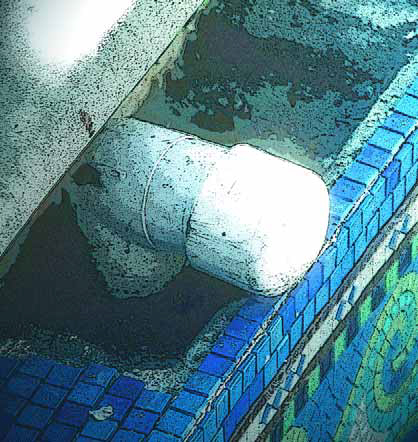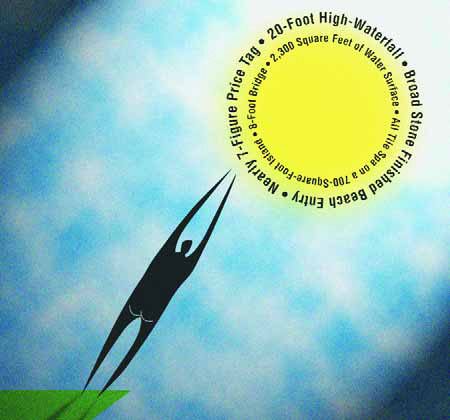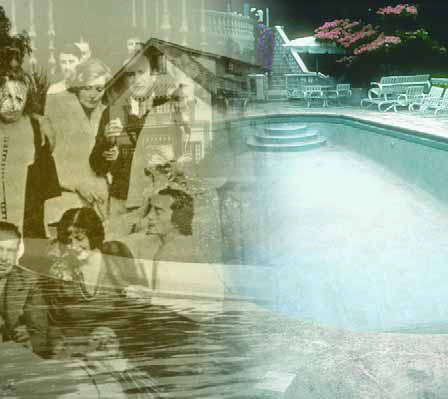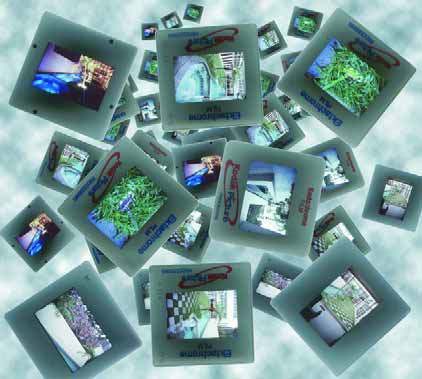spa
Now we come to the finishing touches - little details that make a big difference in the ultimate appearance of the renovated pool we've been watching develop here for the past several months. Through those many months, we've taken a pool that's more than 70 years old, rerouted all of its plumbing through cores cut in the old shell, added a circular spa in the shallow end, raised the floor in the deep end, reshaped the steps, added lights in a new, pool-long bench, installed all-new equipment and laid down gorgeous glass tile throughout - all without disturbing the beautiful limestone decking that surrounded the pool. As the project came to a close, we turned to a final
Water moving in all sorts of different directions (but always in controlled ways) is a hallmark of one our favorite designers, architect David Tardiff. We've built the watershapes for many of his projects, and we've particularly enjoyed those that put both his vigor and special subtlety on display. Time and again, his designs have challenged us technically while rewarding our clients with results that always seem to leave them proud, amazed and thoroughly satisfied. As we've discussed in our previous WaterShapes articles, a large part of our business is about executing watershapes for architects and landscape architects in the backyards of mostly affluent clients in southern California's Orange County. Each designer has his or her own creative style and sensibility, leaving us to adapt the work we do to their "idea sets" while lending our years of practical experience in engineering and construction to the process. In working this way, we find that everyone comes out a winner: The designer creates work that is based in reality; we stretch and expand our skills to realize truly spectacular design concepts; and most important, clients gain refined spaces that hit the mark with respect to both functionality and aesthetics. The two projects we'll visit on these pages are
Finding ways to blend the angular rhythms of modern architecture with the sweeping splendors of nature constitutes one of the more difficult challenges faced by today's watershapers. In the case of the project pictured on these pages, we were contacted in 2002 about an enormous, modern-style home on Mercer Island overlooking the shore of Lake Washington, right near Seattle. The property was being remodeled, and the owners wanted a set of watershapes that would enhance the beauty of the two-acre estate while more convincingly integrating the geometry of the structure with its woodsy lakefront setting. The solution: a set of watershapes that start near the house with perfect geometric forms that stick to the architect's original design, then moves down the hillside through various transitional stages to a pond feature that looks like part of
The renovation project I've been discussing for the past couple of issues will be on hold for a few weeks as we await the arrival of a shipment of custom tile from Italy. We'll pick up with that project once work resumes. In the meantime, let's begin coverage of what would have been the next project for "Details" - discussions that will carry us through a good part of the year to come. Everything about this Pennsylvania watershape has been impressive, right from the start. Simply put, it's one of the biggest and most elaborate projects I've ever tackled. As designed, the watershape will
When we think about how the environments we create are used, the first image that probably comes to mind is one of people enjoying themselves in or near the water on a beautiful, warm afternoon. That's natural - and a vision that's a big part of the watershape experience we set up for our clients - but it ignores the other half of the day when our clients are left to themselves with our work. The fact is that watershape owners are mostly working people who spend their days away from home earning their daily bread. So despite the fact that we build these things
It's right up there for longevity in the history of building materials with marble and concrete: The use of glass tile, in fact, dates to the Roman Empire and traces its path through widespread use in Byzantine art in the eastern Mediterranean before finding its way back to a primary role in the art and architecture of Renaissance Italy. From ancient times forward, glass tile has always been associated with beautiful and enduring works of art. Now enhanced by some modern-day manufacturing practices that serve to bring out its incredible gem-like features, the material still holds faith with all those centuries of tradition while reaching
From pools, spas and fountains to streams, ponds and waterparks, effective watershaping is largely about the plumbing that makes these systems work. If you see things that way, says hydraulics expert Steve Gutai, there's nothing more fundamental to success than making proper connections in the system's plumbing lines, first time, every time, and piping joints that will bear up under pressure for the long haul.
Take it from someone who has ripped out and replaced more than his share of old and failed swimming pools through the years: Some things are worth keeping! That's why it's so wonderful to find an old pool - a product of the industry's infancy - that has stood the test of time and has won the right to be left in place. This is the first in a series of columns on one such pool. It's also the start of a story about clients who appreciate art and style and have surrounded themselves with objects and spaces of true value and beauty. I knew right away that
When you look at this project in finished form, there's no way to see the months of struggle or the overall level of difficulty that went into its creation. You don't see the fact, for example, that we discovered while excavating the courtyard that the house itself was in imminent danger of collapsing. You don't see that the narrow access way buckled when we first started working, or the ugly trauma of the broken septic tank. You can't see the continuous changes in thought, direction and design that went into the deck, or the tremendous time and effort required to make the
Of all the concepts of hydraulic-system design, there are few that have more importance than the correlation between water flow (that is, capacity expressed as gallons per minute) and line velocity (the speed at which the water travels). As water travels through a pipe, its increase in speed (that is, its line velocity) results in an increase in resistance (expressed as feet of head) and in a reduction of end pressure, which is measured in pounds per square inch (psi). In other words, an increase in friction losses and a drop in pressure is the result of increased water velocity at a given flow. If that makes sense to you without further explanation, then you know much of what you need to know when it comes to selecting pipes and fittings and setting up a watershape's plumbing system. If it doesn't, this article will cover the basics - from selecting pipes and sizing lines to






















